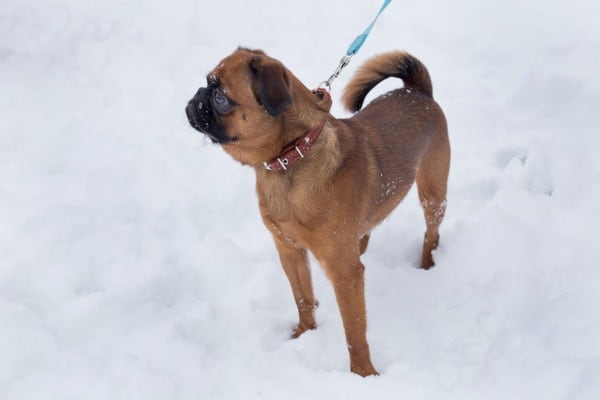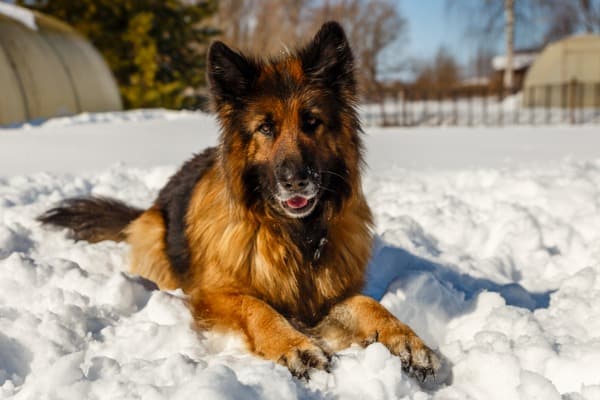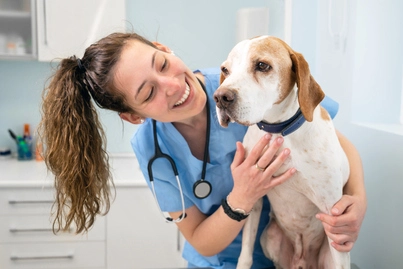Have you ever given your dog’s ears a pet and found them to be cold to the touch?

Or perhaps they rest their head on you, and their ears feel cold to the touch.
If a dog has cold ears, you might be concerned about them – especially if they seem to be particularly frosty.
But this isn’t typically a cause for alarm and frequently has some easy solutions.
Even if it doesn’t indicate any serious health problems, cold ears are something that you should address, as a dog’s body temperature should be stable.
Why?
Whether it’s something a vet should check out or the result of a bitter winter, we’ll take a walk through reasons your best friend’s ears should be kept warm and toasty.
And don’t worry – we won’t suggest earmuffs or hats because we all know dogs aren’t fans of wearing anything on their heads.
Contact a vet?
If you’re at all concerned or see additional accompanying symptoms to your dog’s cold ears, you should call your vet or chat with a vet online to save time and money.
Within minutes you’ll know whether anything serious is going on and what you can do to help your dog’s cold ears and related underlying causes.
Connect with a verified veterinarian in minutes. No waiting for appointments or office hours. No high fees. Your pet's health made convenient and worry-free.
Alert dogs who are acting their usual selves but have cold ears probably won’t need to see a vet – but we’ll cover that soon.
A dog who has other symptoms might need to see the vet for a few reasons.
They Have a Circulatory Issue

Cold ears can be an early sign of a cardiac or circulatory condition.
Although this is more often seen in elderly dogs, it’s important to remember it can happen to dogs of any age.
Other symptoms include cold paws, redness between the dog’s toes, lethargy, or shivering.
Circulatory problems can be caused by anemia, heart defects, or even tumors that are bleeding internally.
In the case that cold ears come with sudden behavioral changes in your dog, it’s not something you should ignore.
They Aren’t Cold – They Have a Cold
Yes, dogs are susceptible to viruses that can cause colds, which can have similar symptoms to human colds.
You might notice your dog has sniffles, frequently sneezes, dry heaves, or has a real cough.
If their ears feel cool or cold to the touch, along with these other symptoms, they might indeed have a cold.
In fact, the same could be true if your dog’s ear are hot to the touch!
Does that mean you can catch their cold? Or you had one and passed it off to them?
The answer is that it’s very unlikely. The cold-causing viruses that infect humans rarely cross to canines, and vice-versa.
So don’t blame yourself if you fall victim to a virus during the cold season. You probably didn’t infect your dog.
The truth is:
Dogs are more likely to pick up colds at vet offices and parks.
If there’s a high influx of colds in your area, avoid these areas if possible.
While colds aren’t typically dangerous for dogs, we all can sympathize with how awful they can make you feel.
It’s not something you want your best pal to go through.
Mild colds usually go away on their own. In the meantime, monitor your dog carefully for any changes in its condition.
Just like with people, dogs with colds should be offered extra water.
Don’t expect them to be up for their daily game of fetch until they feel better. They might sleep extra, which is normal.
Another thing:
Until they fully recover, you’ll want to keep them away from other dogs in the neighborhood.
If you have other dogs in the house, they might have already caught a cold.
But if not, you should separate them from the infected dog while they recover.
Don’t let them share water bowls, toys, or bedding. Keep them from contacting each other, even through a gate.
As a precaution, wash all dishes, bedding items, and toys the infected dog came in contact with. Things that aren’t easily washed, like tennis balls, are better off replaced.
And if your dog seems like they’re acting like a big baby, try to remember how you feel when you catch a cold.
They might become extra clingy around you, and indulging them with cuddles is both fine and encouraged.
Yes, a dog sneezing on you is high on the “yuck” scale, but it’s highly unlikely to make you sick with their cold.
Blame Cold Ears on the Weather

The scenario: it’s the middle of winter. There may or may not be snow on the ground. The wind chill is unbearable.
Each of these things alone can cause your dog to be as cold as you are if you step outside.
And their ears are especially susceptible to feeling the chill of winter.
Ever walk outside in the winter without proper head protection? You probably know that ears get cold a lot quicker than other body parts.
But why is that?
Ears – both human and dog – are made mostly of cartilage.
Cartilage doesn’t have any blood vessels running through it – basically, there’s no blood running through ear cartilage to help regulate the temperature.
Here are some great products we like that will definitely help with your pooch’s cold ears.
Best of all, they’ll look nice and snazzy, too, while they feel more comfortable.
Plus, the body will prioritize vital areas to keep warm when exposed to cold.
And while your ears are important, the body isn’t overly concerned with keeping them warm – it’s more worried about extremities and vital organs.
So dogs’ ears feel cool in cold temperatures for the same reasons ours do.
But what about their fur?
Yes, it’s true that they have an extra barrier against frigid temperatures.
But you’ve probably noticed that few dogs have overly fluffy ears.
Most breeds have thinner hair and a less dense coat around their face and ears.
So while this can help them stay warmer for longer, it isn’t a foolproof solution to winter weather.
Are Some Dogs More Likely to Get Cold Ears Than Others?
Absolutely.
Breed, age, and size can all dictate how well a dog will fare in the cold.
Smaller Breeds
To begin with, a small or toy-breed dog has less heat simply because they are so tiny.
The less heat they have, the quicker cold air will sap it from their body.
So smaller breed dogs can’t tolerate colder temperatures for as long as their larger cousins.
Also, keep in mind that six inches of snow are enough to practically bury a small dog.
Plowing through it can not only tire them out; it can make them wet, which can make it even harder to keep warm.
Short-haired toy breeds are particularly vulnerable. A coat or sweater can help, but keeping them warm is not a magical solution.
Any temperature under 45 degrees can make them chilly, and anything below freezing is too cold for anything more than quick potty trips outside.
Dogs With Prominent, Erect Ears

Think Huskies, Corgis, Cattle Dogs, German Shepherds, and Malamutes.
Even a Basset Hound’s large ears are a target for chilly temperatures.
But aren’t some of these dogs bred for cold weather?
They definitely are, and they can tolerate much colder weather for longer durations than other breeds.
Any arctic breed can take the cold surprisingly well, and if one of these dogs is part of your family, you know they actually love winter.
There’s one catch – they’re still not totally immune from the cold.
Don’t overestimate their ability to feel the cold because some circumstances can make them uncomfortable.
Why does the shape of their ears matter?
Because they stand upright and away from their body, they aren’t as protected.
Their ears can also act as “sails” in windy conditions and be a target for freezing gales.
If you notice your dog is pinning or drooping their otherwise erect ears, they’ve probably had enough of the wind chill.
Short-Haired Breeds
Hounds, terriers, labs, and pugs are all examples of dogs with short hair.
Because they don’t have thick insulation, they’ll feel the cold sooner than long-haired dogs with undercoats.
Again, sweaters and coats can offer them some comfort in the wintertime.
But they will still struggle to maintain body heat if they’re exposed to it for too long.
Puppies and Elderly Dogs

Like small-breed dogs, puppies have less body heat to lose.
Even in arctic breeds, young puppies haven’t yet developed a full coat, so their natural protection isn’t ready for extreme cold.
Does this matter?
While your puppy might have the time of their life playing in their first snow, when their ears start feeling chilly, they’ll need a break to warm up.
Older dogs have a lower capacity to retain body heat. They often have a lower fat content, which is vital for insulation.
Plus, chilly temperatures can aggravate arthritis and achy joints.
Dogs Who Have Never Experienced Cold
Any dog born and raised in a warm climate might not tolerate cold immediately.
Moving or visiting a colder region than your dog is used to might mean acclimating them to it slowly.
Don’t be surprised if your dog, who has grown up around beaches and deserts, acts like a bit of a wimp when exposed to winter.
But fortunately, dogs adapt well. With the help of some stylish sweaters, they might even come to love winter.
What Are the Risks of Overexposure to the Cold?
Dogs can fall victim to frostbite as we can. The ears, feet, and tail are especially susceptible.
It is vital to understand that dogs cannot be left outside for extended periods if it is below freezing.
Outdoor dogs are at risk for frostbite, hypothermia, and even death if they’re not properly cared for in cold weather.
If you have an “outside” dog, don’t make the mistake of thinking a doghouse and bedding are enough to keep them warm.
There’s a limit!
While shelter from wind, snow, and ice is good, there is a point where they need to come indoors for their own protection.
Outside dogs should have the option of a heated structure, or better yet – bring them into your home until the weather is safe for them to be back outside.
Letting a dog stay outside in frigid temperatures in many states and cities is considered animal cruelty and a chargeable offense.
If your pet shares your house with you, you should still be careful keeping them outside in bad weather.
Frostbite or hypothermia are serious but entirely preventable conditions.
How Do I Know My Dog is Too Cold?

As mentioned earlier, anything below freezing will become a problem in a short amount of time.
The duration a dog can tolerate freezing temperatures will depend on their size, and age.
So paying attention to your dog’s body language is essential.
Good news for us humans: thousands of years of dogs evolving alongside people means we can read them pretty effectively, provided we pay attention.
They’re Shivering
This one is probably obvious, but a shivering dog is ready to come inside and warm up.
They’re Curling Up In a Ball
If they do this inside, it could be an indication you need to bump up the heat a little.
Dogs will curl up in a round “croissant” shape when they feel chilly.
Dogs with long, fluffy tails will often use it to cover their nose against the cold.
They might also curl up close; your dog choosing to sit on you, or in some cases, squeeze in and sit behind you on the couch!
Large dogs can forget their size very quickly when they see you as a heat source.
They’re Moving Slowly
If your dog isn’t acting as spry as they usually do, and their ears are feeling icy, then they’ve probably had enough of the cold.
They might even limp if the cold has caused a leg to become stiff and achy.
They’re Whining
Dogs whine to communicate with us.
While they can’t swear at the weatherman when they find out the cold temps aren’t going anywhere, they can protest in other ways.
If their ears are cold, they’re whining, and the thermometer just dropped, they’re probably complaining about the cold.
Bundle Up the Pup
There are several ways you can keep your dog comfortable during freezing weather.
Even if they hate wearing the hat grandma knitted them, they don’t have to suffer from cold ears all season.
Providing extra bedding (bonus points for snuggly blankets), limiting playtime outside, and doggie winter gear all go a long way in keeping your baby toasty when the arctic blast hits.
Cold Ears, Don’t Fear
If you’re cuddling with your pet and think to yourself, “my dog’s ears are cold,” it’s rarely anything you should call your vet over.
Any of the additional symptoms we talked about require your attention, but usually, their ears are cold simply because it’s cold outside.
So when cold ears only happen when the weather takes a turn, and your dog displays no other changes, you can rest easy.
Be sensitive to your dog’s needs, bust out the sherpa blanket, and take advantage of your dog’s extra cuddly demeanor.
A warm, furry bundle is just the thing to keep you warm while you wait for spring.




